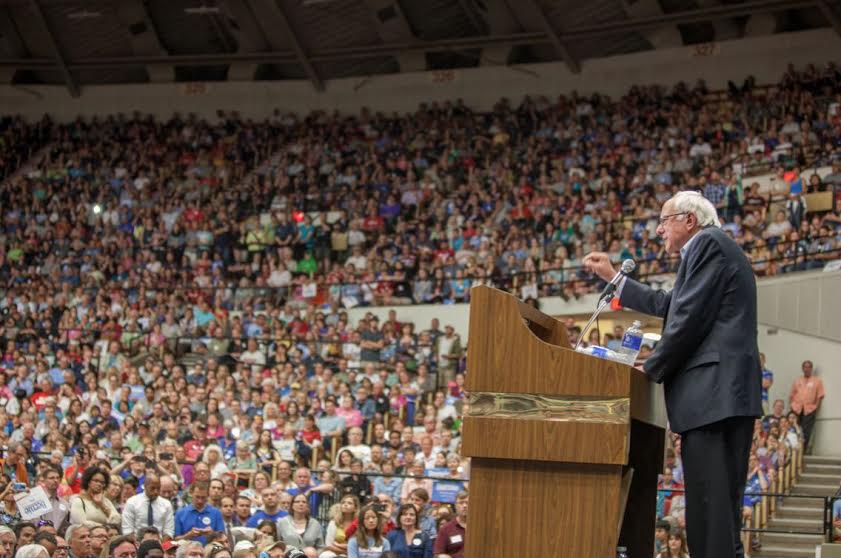The established political order in the US has been shaken up by Bernie Sanders’ campaign for the Democratic presidential nomination. Not only has he tapped into a widespread anti-corporate mood, he has also fired up interest in socialist ideas. TOM CREAN reports on the impact of his campaign, and the tasks it sets for the workers’ movement.
The 2016 US presidential campaign is in full swing and its key lesson so far is that, despite the avalanche of money from the super-rich, the huge anger of working people and big sections of the middle class at the establishment is finding expression. In the Democratic Party, Bernie Sanders – a self-declared democratic socialist whose call for a ‘political revolution’ against the billionaire class has excited hundreds of thousands – is building a serious challenge to Hillary Clinton. Only a few months ago, the media portrayed Clinton as a shoo-in for the Democratic nomination. More ominously, Donald Trump, notorious for his call to deport all eleven million undocumented immigrants in the US, has been leading the polls on the Republican side for months. His right populist appeal has created an enormous headache for the party’s elders.
These developments are the political reflection of the deep crisis of the capitalist system beginning in 2007-08 which led to savage attacks by the ruling class against the public sector and workers’ rights. This was followed by an economic recovery which has overwhelmingly benefited the rich. The latest data from the US Census Bureau shows that median household income in the US was 6.5% lower in 2014 than in 2007. The jobs being created are overwhelmingly low paid and working conditions are worsening.
Since 2011 we have seen growing resistance, beginning that year with the uprising of workers and youth in Wisconsin against the state’s newly-elected right-wing governor, Scott Walker, who set out to destroy public-sector unions. A few months later, the Occupy movement exploded on the national scene, raising the banner of the 99% and putting the question of inequality firmly on the agenda. Since the killing of Michael Brown in Ferguson, Missouri, just over a year ago, tens of thousands of black youth have taken the road of struggle. And the fast food workers’ actions for $15 an hour and a union have led to a movement to raise the minimum wage at local level. This first succeeded in Seattle in 2014 after the election of Socialist Alternative’s Kshama Sawant to the city council.
Citizens United
But in terms of national politics it is the domination by corporate interests – through an army of lobbyists and massive campaign donations as well as the never-ending dysfunction in Congress – which has provoked the most outrage. In 2010, the US Supreme Court effectively ruled in the Citizens United case that there could be no restrictions placed on corporate spending in federal elections. Since then there has been a flood of money from the super-rich, particularly into so-called ‘Super PACs’ (political action committees) that pay for ads on behalf of candidates while nominally being independent of their campaigns.
As the New York Times reported (11 October), in this election cycle a mere 158 families have contributed an incredible $176 million, fully half of the total raised to support all the candidates so far. The bulk of the money from those families is going to Republican candidates. Most of these donors have made their fortunes in finance or the energy sector and are primarily focused on removing any regulation or taxation affecting their profits.
The same article points out, though, that the overwhelmingly right-wing views of the 158 families are not in sync with those of ordinary people: “Two thirds of Americans support higher taxes on those earning $1 million or more a year… while six in ten favour more government intervention to reduce the gap between rich and poor… nearly seven in ten favour preserving Social Security and Medicare [basic government pension and public health insurance for people over 65] as they are”.
Many liberal commentators have said that there is no way to resist the deluge of corporate cash unleashed in the wake of Citizens United. This type of fatalism is usually connected to the idea that progressive workers and youth have no choice but to support the ‘lesser evil’ corporate-approved alternative.
But Bernie Sanders’ fundraising shows this fatalism is false. Uniquely among the presidential candidates in the two main parties, Sanders has refused to take money from big business. Nevertheless, in the three months from July to September, his campaign raised $26 million, almost as much as Hillary Clinton’s, and he has almost as much cash in hand as she does. His campaign has 650,000 donors, typically giving $30 each. Besides showing how Sanders’ campaign has tapped into mass anger at the ruling elite, this is also an indication of the potential to mobilise resources for independent working-class politics in the US in the next period.
Historic campaign
Sanders’ campaign is part of an international trend, including the rise of Syriza in Greece, Podemos in Spain and Jeremy Corbyn’s dramatic ascent to the leadership of the British Labour Party. In all these cases, sections of the working class and youth have been looking for a way to push back against austerity, neo-liberalism and to break up the established political order. Like Corbyn, Sanders’ campaign has also led to a surge of interest in socialism.
At the first Democratic debate on 12 October, watched by a record audience of 15 million, Sanders was questioned about calling himself a socialist. He responded that, “democratic socialism is about saying that it is immoral and wrong that the top one-tenth of 1% in this country… own almost as much wealth as the bottom 90%”.
When he was then asked jokingly if he was a capitalist, Sanders retorted: “Do I consider myself part of the casino capitalist process by which so few have so much and so many have so little, by which Wall Street’s greed and recklessness wrecked this economy? No, I don’t. I believe in a society where all people do well. Not just a handful of billionaires”.
The website vox.com reported that Sanders’ debate contributions led to a spike in searches for the word ‘socialism’ on the online Merriam-Webster dictionary. This comes on top of a series of polls in recent years showing vastly increased support for socialism as a broad concept, especially among people under 30.
Key aspects of Sanders’ programme have wide appeal. This includes his support for a $15 federal minimum wage; free tuition for all public colleges and universities; breaking up the big banks; ending the policies which have led to the mass incarceration of black youth; and opposing corporate-approved trade deals like the recently unveiled Trans Pacific Partnership (TPP) between the US and eleven other countries on the Pacific Rim.
Key contradiction
Socialist Alternative (the US sister organisation of the Socialist Party) has welcomed Sanders’ candidacy because it is contributing to the radicalisation of millions of people. Unlike some on the left we have chosen to actively engage Sanders’ supporters rather than stand on the sidelines because Sanders is running in the Democratic primaries. When Sanders was considering whether to run, we urged that he should do so as an independent with the goal of using his campaign to help lay the basis for a new party of the left. One can debate whether he would have created the same level of enthusiasm as an independent left candidate, but he could definitely have reached millions on a clearer basis and created a political instrument for working people that would have lasted beyond his campaign.
But since he made the decision to run in the Democratic primaries, we have urged him to continue his campaign as an independent were he to lose the primaries, and certainly not to support the Democratic Party’s eventual Wall Street-backed nominee. Sanders has said previously that if Clinton wins the Democratic nomination he would support her. This would be a serious mistake. Socialist Alternative has consistently stressed the central contradiction of Sanders’ campaign: that it is trying to challenge the corporate domination of politics while accepting the framework of the thoroughly corporate-dominated Democratic Party. We have also explained our disagreements with Sanders on a number of issues, particularly on foreign policy.
Sanders has declared that he wants to avoid a ‘negative’ campaign. In one sense this is understandable given the vicious slanders that many US politicians like to engage in, rather than discussing real issues, but how can Sanders’ campaign defeat determined and ruthless establishment foes like Clinton unless it brings the fight to them?
It is clear that the more Sanders’ campaign looks like a real electoral threat, the more the corporate elite with its huge resources, including the vast array of media outlets it controls, will go on the attack. In fact, this has already begun with vicious attacks on Sanders in the likes of the New York Times in the wake of the televised debate.
A real political revolution
The central question, however, is not Sanders himself but how the process evolves, and particularly what conclusions his legion of supporters draws from this experience. The key question Socialist Alternative members have been raising at local People for Bernie meetings and mass rallies is: how will we actually achieve the bold progressive demands that have galvanized people into action? Or to put it another way: what does a real political revolution against the billionaires look like?
First of all, it is necessary to build a mass movement against inequality, poverty and racism in workplaces, communities, campuses and on the streets, centered on the social power of the working class. Sanders himself has called for mass action, including a million-student march in Washington for free college education. This would be an excellent start.
But what is also critical is to begin now to build a new political force, independent of all corporate influence, that really represents the interests of the 99%. This is not compatible with remaining in the framework of the Democratic Party. Many of Sanders’ supporters have become understandably excited about the possibility of him winning the Democratic nomination which, despite his increased poll numbers, we think remains remote.
However, even if his campaign were to overcome all the obstacles in the primaries intended to weed out radical challengers, without making fundamental compromises, the apparatus and the bulk of the elected Democratic Party officials would work overtime to undermine him in the general election. A Sanders presidency is simply not acceptable to any section of the ruling class, not so much because his politics represents a fundamental threat to their system but because of the aspirations and expectations such a development would trigger among huge sections of working people.
Many of Sanders’ supporters agree – despite their enthusiasm for him standing in the primaries – that the Democratic Party cannot ultimately be used as the vehicle to win such a radical programme. We are highlighting these points precisely in order to help organise and move the broadest possible section of the hundreds of thousands inspired by his campaign beyond the framework of the Democrats. The discussion about the way forward will heat up as the primary votes approach, first in Iowa and New Hampshire next February, and will sharpen if Sanders wins one of these contests on the road to ‘super Tuesday’ in March, when a large number of states hold their primaries.
The danger of right populism
The importance of Sanders’ campaign should not, however, blind us to the real danger of right-wing populism which has also asserted itself in the early stages of this election cycle. Besides Trump, the billionaire real estate developer, Ben Carson, a black neurosurgeon, has also received significant support, particularly from Christian conservatives, by arguing, for example, that a Muslim should not be allowed to become president of the US.
But Trump remains the key expression of this phenomenon. Much of the liberal left has spent its time deriding Trump as a buffoon. While this may be an entertaining Facebook pastime, it does not help us to understand the appeal he has for a section of the white middle class and working class. One element of this appeal is that Trump has repeatedly pointed out how politicians are bought by the ‘donor class’ including himself.
When asked at the first Republican debate about his donations to Democrats, he replied: “You better believe it… I will tell you that our system is broken. I gave to many people. Before this, before two months ago, I was a businessman. I give to everybody. When they call, I give. And you know what? When I need something from them, two years later, three years later, I call them. They are there for me. And that’s a broken system”.
Trump offers himself as a billionaire financing his own campaign who cannot be bought by special interests; he’s his own special interest. But at a deeper level he and other right populists tap into the deep uncertainty created by the economic crisis and cultural and demographic change. Besides appealing explicitly to anti-immigrant sentiment which is again on the rise among sections of the population after receding for a period, he also talks about restoring the dominance of the US globally and ‘making America great again’.
Despite Trump and Carson’s current strength in the polls, the most likely scenario is that the ridiculously large Republican field of candidates will start to thin significantly after the first couple of primaries and the establishment will rally around an ‘anti-Trump’ candidate. But even if Trump finally fades, in the absence of a fighting labour movement or a strong organised left, the space for right populism can grow, reinforcing divisions within the working class. This shows the urgency of using the current opening, created by mass disgust with the establishment and broad sympathy with left demands, to make a breakthrough for independent working-class politics.
What will a new party look like?
Of course, seizing this opportunity is not straightforward and raises many complex questions. The two capitalist parties maintain a virtual monopoly at national level and the organised left is very weak on the ground. Lesser evilist arguments continue to have a major effect on large sections of progressive workers, youth, women and LGBTQ people, especially in national elections. This is because of the overt hostility of the Republicans to the rights of workers, women and other oppressed sections of society and the current lack of a viable alternative. But this dynamic is much less evident at local level where many large and medium sized cities are virtual one-party states, usually dominated by the Democrats.
When Socialist Alternative member Kshama Sawant was elected to the Seattle city council with over 95,000 votes in November 2013 in a citywide race, the local media soon began to refer to Socialist Alternative as Seattle’s ‘second party’. Given the almost complete absence of an organised Republican Party in Seattle this was essentially accurate. Over the course of the past two years, Kshama and Socialist Alternative have had a dramatic effect, helping to force a clear shift to the left in Seattle’s politics and creating a model of what could be accomplished in other cities in the next period, and then extended to Congressional races.
One of the challenges in trying to make the case for a new political party of the 99% to a wider audience is to explain what such a party would look like given the lack of any recent models in the US. It would have to be a party of struggle rooted in workplaces and communities, linking the movements in the streets to the fight against both corporate parties in city councils and Congress. Such a party must also have a genuinely democratic internal life and accountable structures so that the lessons of struggles and political campaigns can be fully assimilated and thereby strengthen the party’s roots in the broader working class.
The Seattle model
This is the type of politics Socialist Alternative sets out to develop in Seattle. Kshama’s 2013 campaign focused on the call for a $15 an hour minimum wage, based on the impact of the national days of action by fast food workers, and our victory helped to take this issue to a new level. Through building a grassroots campaign, 15Now, in Seattle with the support of key unions, Socialist Alternative and Kshama played a leading role in achieving the first local $15 minimum wage in the country in 2014, which led to further breakthroughs in Chicago, San Francisco and Los Angeles.
Now Kshama and Socialist Alternative are fighting to win rent control in Seattle and to push back against the profit lust of the developers and their allies in the political establishment. This battle also has important national repercussions, as working people in city after city face rapid rent increases and destructive gentrification. The victory on the minimum wage and the fight around other social issues is also helping to spur the Seattle labour movement into greater activity, as evidenced by the recent five-day teachers’ strike. This shows how developments on the political plane can help to spur social struggle and working-class activity.
While national attention increasingly focuses on the presidential race, the key immediate battle for the US left is re-electing Kshama Sawant in November. Kshama’s campaign has raised over $400,000 (like Bernie Sanders, overwhelmingly from small donations) which would have been previously thought impossible for a socialist in a local race. This type of fundraising is necessary because equally large amounts of corporate money are flowing into the campaign of our opponent. The ruling elite also sees the importance and for them the danger of the model of left politics that is developing in Seattle.
But Kshama’s re-election is also essential because it will give US socialists a platform to intervene in the key national developments that will unfold in 2016. Then, we could see significant steps towards establishing a new left political force, especially as a huge debate unfolds within and around Sanders’ campaign about the way forward to achieve real change for working people.












